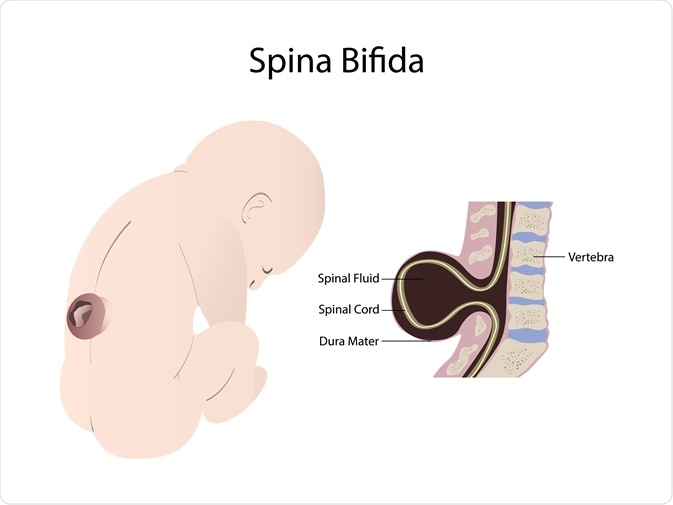Spina bifida is characterized by an opening of the spine, which originates from the formation of the neural tube in the first month of development of the embryo.
 Image Credit: Nasky / Shutterstock.com
Image Credit: Nasky / Shutterstock.com
Neural tube formation
Three weeks after conception, the first signs of the central nervous system appear in a human embryo in what is known as the neural plate. The lateral edges of the plate elevate to form neural folds, turning in on each other and fusing together to create the neural tube. Between the 23rd and the 26th day after conception, the closure of the cranial and then the caudal neuropore occurs.
The period of time directly after the closure, from the 26th to the 30th day, is the crucial moment for the formation of the neural tube and disruptions in the process can cause defects such as spina bifida. It is worth noting that many women may not be aware that they are pregnant this early and, for this reason, it can be difficult to intervene to prevent defects of the neural tube.
Genetic link
Spina bifida does not follow a distinct pattern of genetic inheritance and the vast majority of cases – more than 95% - occur in families without a history of spina bifida.
However, a genetic link to the condition has not been denied for several reasons. Animal models have suggested a genetic basis for the condition, although current research has not shown this to correspond to human genomes. Additionally, a couple that has previously had a child with spina bifida is significantly more likely to have a second and third child with the condition. Likewise, an individual with a family history of spina bifida has a higher risk of being affected.
Therefore, genetic susceptibility is thought to play a role in the pathophysiology of spina bifida but environmental factors are also important.
Environmental factors
There are several individual lifestyle factors of the mother that can affect the likelihood of having a child with spina bifida.
Women with excess weight, those with a BMI higher than 30, are associated with an increased risk of giving birth to a child with spina bifida. Similarly, women with diabetes have an increased risk, which is thought to be related to the presence of excess glucose in the bloodstream.
Specific medication use by mothers has also been linked to infants born with spina bifida and other birth defects. The anticonvulsant drugs often used in the treatment of epilepsy, valproate and carbamazepine, are particularly prone to this. In most cases, these medications are substituted for other pharmaceutical alternatives if a woman is planning to become pregnant. Additionally, any woman of childbearing age should use adequate contraception to reduce the risk of an unexpected pregnancy.
Spina bifida (myelomeningocele, meningocele, occulta) - an Osmosis Preview
Role of folic acid
Although the mechanism of action remains unknown, there is considerable research to support folic acid supplementation for the prevention of spina bifida. For this reason, high doses of folic acid a recommended before and during pregnancy and are particularly important during the first month of the pregnancy.
In recent decades, cereal food products have often been fortified with folic acid to increase the intake of the general population. This is seen as a particularly beneficial intervention as neural tube defects form early in the pregnancy, often before the woman is aware she is pregnant if it is unplanned. This practice has not been mandated in all countries throughout the world, however, due to safety concerns about the effect on elderly populations and possible increased risk of colon cancer.
References
Further Reading